Are you curious about why you suddenly see a massive influx of flying ants? This article from flyermedia.net explores the phenomenon of “flying ant day,” delving into the reasons behind these synchronized aerial displays. We will break down the science of swarming behavior and show what it means to the ecosystem and the life cycle of these fascinating insects. Understanding nuptial flight and swarm intelligence, as well as garden ant facts, can help us appreciate their role in the environment.
1. What Exactly Are Flying Ants?
Flying ants, scientifically known as alates, are sexually mature queens and males of ant species. In the UK, particularly in urban areas, these winged insects are typically black garden ants, Lasius niger. The queens are larger, reaching up to 15mm in length. Their sudden appearance often catches our attention, and the underlying reasons are quite intriguing.
1.1 What Role Do Flying Ants Play in the Ecosystem?
According to research from the Royal Society of Biology, alates are essential because new queens establish new colonies. Their tunneling activities aerate the soil, and they provide a vital food source for birds like swifts and gulls. The black garden ant helps the survival of the silver-studded blue butterfly by protecting their caterpillars.
1.2 How Can I Identify Flying Ants?
Flying ants, or alates, are sexually mature ants ready for nuptial flight. You can identify them by their:
- Wings: Presence of two pairs of wings, longer than their body.
- Size: Queens are larger than worker ants, around 15mm.
- Color: Commonly black, but can vary by species (e.g., red ants).
- Behavior: Swarming in large numbers, especially during warm weather.
- Location: Often seen in gardens, pavements, and near ant nests.
2. When Does Flying Ant Season Occur?
The annual swarming event typically happens in July or August, coinciding with hot and humid weather. The exact timing varies depending on local conditions. Urban areas often see flying ants earlier than rural areas due to warmer temperatures, a phenomenon known as the urban heat island effect.
2.1 Is There Really a “Flying Ant Day”?
The Royal Society of Biology’s multi-year citizen science project debunked the idea of a single ‘flying ant day’. Instead, it’s a ‘flying ant season’ spanning several weeks, with peaks lasting a few days each. Swarming is triggered by warm, windless weather after improved conditions from the previous day.
2.2 What Weather Conditions Trigger Flying Ant Swarms?
- Warm Temperatures: Ants fly on warm days.
- Low Wind: Calm conditions are essential for flight.
- Improved Weather: Swarming occurs after conditions improve from the previous day.
- Humidity: Often happens after summer rain, creating humid conditions.
3. Where Do Flying Ants Originate?
Before swarming, ants live in colonies within nests in dry soil. Black garden ants commonly nest in flower beds, lawns, and under paving slabs. These areas are typically dry and warmed by the sun, including gardens, pavements, brownfield sites, and coastal regions.
3.1 How Can I Spot an Ant Nest Before the Swarm?
- Soil Heaps: Look for small heaps of soil near flower beds or lawns.
- Paving Slabs: Check under paving slabs or stones.
- Dry Areas: Inspect dry, open areas warmed by the sun.
- Patios: Patios are favored nesting locations.
3.2 How Do Ant Colonies Function?
Ants operate within a caste system. The queen lays eggs, while female workers care for the queen, eggs, and larvae. Workers also gather food, expand the nest, and maintain the colony. The queen produces virgin queens and males when the colony is ready for reproduction.
4. Why Do Ants Develop Wings and Fly?
Ants develop wings and fly because a new queen needs to establish a new colony. She must mate with a male from a different colony and find a new nesting area. Wings enable her to accomplish this.
4.1 What is Nuptial Flight?
Nuptial flight is when winged males (drones) and virgin queens (princesses) emerge from the nest to mate. This flight ensures mating between different colonies, reducing inbreeding. Large winged females and smaller winged males are often seen flying together.
4.2 What Is The Purpose Of Flying Ants?
According to the Entomological Society of America, alates fly in large numbers to mate and form new colonies. The large numbers of alates increase the likelihood of successful mating encounters and improve survival rates for new queens.
5. Why Do Flying Ants Swarm in Such Large Numbers?
Swarming in large numbers provides protection from predators. Safety in numbers deters potential threats. It also increases the chance of successful reproduction, ensuring mates are readily available. During this brief mating period, a queen usually mates with several males, and this strategy is very successful for their survival.
5.1 How Does Swarming Protect Flying Ants?
- Predator Dilution: Overwhelms predators with sheer numbers.
- Increased Mating Opportunities: Ensures successful reproduction.
- Confusion Effect: Makes it difficult for predators to target individual ants.
- Synchronized Emergence: Coordinated timing maximizes survival chances.
5.2 What Happens After the Nuptial Flight?
Following mating, males’ roles end. Mated queens chew off their wings and seek suitable nesting sites to start new colonies. This explains why you often see wingless ants walking around post-‘flying ant day’ with discarded wings nearby.
6. What Is the Lifecycle of a Flying Ant?
The life cycle of a flying ant is closely tied to its role in reproduction and colony establishment. Understanding this lifecycle helps appreciate their brief but critical appearance. Here’s a breakdown of the stages:
6.1 What Are The Stages Of A Flying Ant’s Life?
- Larva: Hatched from eggs laid by the queen, larvae are fed and cared for by worker ants.
- Pupa: After several molts, the larva transforms into a pupa, developing wings and adult features inside a cocoon.
- Alate (Winged Adult): The pupa emerges as a winged adult (queen or male), ready for the nuptial flight.
- Nuptial Flight: Alates leave the nest to mate with individuals from other colonies.
- Mating: Queens mate with multiple males during the flight, storing sperm for future fertilization.
- Wing Shedding: After mating, queens chew off their wings and search for a suitable nesting site.
- Colony Founding: The queen digs an underground chamber, lays eggs, and starts a new colony, using stored sperm to fertilize eggs for the rest of her life.
- Death: Males usually die shortly after the nuptial flight.
6.2 How Long Do Flying Ants Live?
Males typically live only a day or two after the nuptial flight, totaling about a week. Their sole purpose is to mate with new queens. Lasius niger queens can live up to 15 years, spending most of their lives in the nest. They only spend a small portion of their lives as winged ants, establishing new colonies.
7. Are Flying Ants Beneficial?
While they may seem annoying, flying ants offer several benefits:
- Soil Improvement: Their tunneling aerates the soil, enhancing its quality.
- Food Source: They serve as a vital food resource for birds.
- Ecosystem Support: They aid the survival of species like the silver-studded blue butterfly.
7.1 How Do Flying Ants Improve Soil Quality?
According to a study published in Applied Soil Ecology, flying ants improve soil quality by digging tunnels which aerate the soil, and redistributing nutrients. This enhances soil structure and fertility, benefiting plant growth.
7.2 What Is the Relationship Between Flying Ants and the Silver-Studded Blue Butterfly?
The black garden ant and the cornfield ant are crucial to the survival of the silver-studded blue butterfly on heathland. Ants protect butterfly caterpillars from predators, and in return, they feed on secretions produced by the caterpillars, forming a mutually beneficial relationship.
8. What Species of Ants Fly in the UK?
Ants, along with bees and wasps, belong to the Hymenoptera insect group. They are identified by their three distinct body parts. There are about 60 ant species in the UK, all living in complex colonies.
8.1 Do Red Ants Fly?
Yes, red ants (Myrmica rubra) are among the common ant species in Britain that grow wings and swarm. However, most winged ants observed are black garden ants (Lasius niger).
8.2 Where Can Different Types of Flying Ants Be Seen?
The types of flying ants you see depend on your location. For example, you might see wood ants in woodland areas. All ants need good weather to fly, avoiding rain or wind. The temperature and humidity triggering swarming varies by species, affecting their nuptial flight timings.
9. How Can I Manage Flying Ants Around My Home?
While flying ants are beneficial to the environment, their presence can be a nuisance around your home. Here are some practical tips to manage them without harming the environment:
9.1 What Are Some Natural Ways to Deter Flying Ants?
- Peppermint Oil: Dilute peppermint oil with water and spray around entry points. Ants dislike the strong scent.
- Vinegar Solution: Mix equal parts of vinegar and water and spray on ant trails and nests.
- Lemon Juice: Spray lemon juice around doors, windows, and other areas where ants enter.
- Cinnamon: Sprinkle cinnamon powder around areas where ants are present.
- Boiling Water: Pour boiling water into visible ant nests to eliminate the colony.
9.2 How Can I Prevent Flying Ants from Entering My Home?
- Seal Cracks: Seal cracks and crevices in walls, windows, and doors to prevent entry.
- Clean Up Food: Clean up food crumbs and spills immediately to avoid attracting ants.
- Store Food Properly: Store food in airtight containers to prevent ants from accessing it.
- Trim Vegetation: Trim vegetation around your home to reduce ant access points.
- Maintain Cleanliness: Keep your home clean and clutter-free to minimize hiding spots.
10. Why Is Understanding Flying Ants Important for Aviation Enthusiasts?
For aviation enthusiasts and professionals, understanding natural phenomena like flying ant swarms highlights the broader ecological context in which aviation operates. Awareness of such events helps in:
10.1 How Do Flying Ants Affect Aviation?
- Awareness of Environmental Impact: Being aware of the ecosystem helps aviation professionals to take informed decisions on impact.
- Wildlife Management: Understanding insect behavior aids in managing wildlife interactions around airports.
- Appreciating Nature’s Complexity: Recognizing the complexity of natural events enriches the aviation community’s perspective.
10.2 How Can I Learn More About Aviation and Entomology?
- Visit flyermedia.net: Get all the facts you need at flyermedia.net and discover a wide range of articles on aviation.
- Attend Seminars: Look for seminars on aviation and environmental science.
- Engage with Experts: Connect with professionals in both aviation and entomology.
In conclusion, flying ants are fascinating insects with a crucial role in the ecosystem. Their swarming behavior, driven by mating and colony establishment, is a natural phenomenon that contributes to soil health and supports other species. While they may be a temporary nuisance, understanding their life cycle and benefits can help us appreciate their significance.
Ready to learn more about the fascinating world of aviation? Visit flyermedia.net for in-depth articles, news, and resources. Whether you’re an aspiring pilot, aviation enthusiast, or industry professional, flyermedia.net offers comprehensive coverage to fuel your passion.
Are you facing challenges in navigating the complexities of the aviation world?
- Looking for a reputable flight training school?
- Need help understanding aviation regulations?
- Seeking the latest aviation news and trends?
- Exploring career opportunities in the aviation industry?
- Want to find the best airlines and flights for your travel needs?
- Need advice on resolving issues during air travel?
- Interested in learning about different types of aircraft and aviation technology?
Flyermedia.net is here to help!
We offer a comprehensive list and reviews of top flight training schools in the USA, clear explanations of aviation regulations, the latest aviation news from around the world, job opportunities in the aviation sector, comparisons of airlines and flights, travel tips, and insights into aircraft and advanced aviation technologies.
Take Action Now! Visit flyermedia.net today to find the information you need and fulfill your aviation dreams.
Address: 600 S Clyde Morris Blvd, Daytona Beach, FL 32114, United States
Phone: +1 (386) 226-6000
Website: flyermedia.net
FAQ About Flying Ants
1. Why are there so many flying ants in my garden?
Flying ants swarm in large numbers for mating purposes. This increases the chance of successful reproduction and survival for new queens.
2. What is the best way to get rid of flying ants?
Natural deterrents like peppermint oil, vinegar solution, lemon juice, or cinnamon can help. Pouring boiling water into visible nests is also effective.
3. Are flying ants dangerous?
Flying ants are generally harmless to humans. They do not bite or sting unless provoked.
4. How long does flying ant season last?
Flying ant season typically lasts for several weeks in July and August, with peak swarming periods lasting a few days each.
5. What attracts flying ants to my home?
Food crumbs, spills, and open food containers attract flying ants. Seal cracks and store food properly to prevent them from entering.
6. Can flying ants damage my property?
Flying ants do not typically damage property. They nest in soil and do not bore into wood like termites.
7. What should I do if I see a flying ant nest?
Pour boiling water into the nest or use natural deterrents. Sealing entry points can prevent them from returning.
8. Are flying ants the same as termites?
No, flying ants and termites are different insects. Flying ants have three distinct body parts and bent antennae, while termites have a uniform body and straight antennae.
9. Do flying ants bite?
Flying ants do not usually bite unless they feel threatened. Their bites are not harmful.
10. How do flying ants contribute to the ecosystem?
Flying ants aerate the soil through tunneling, provide a food source for birds, and support species like the silver-studded blue butterfly.
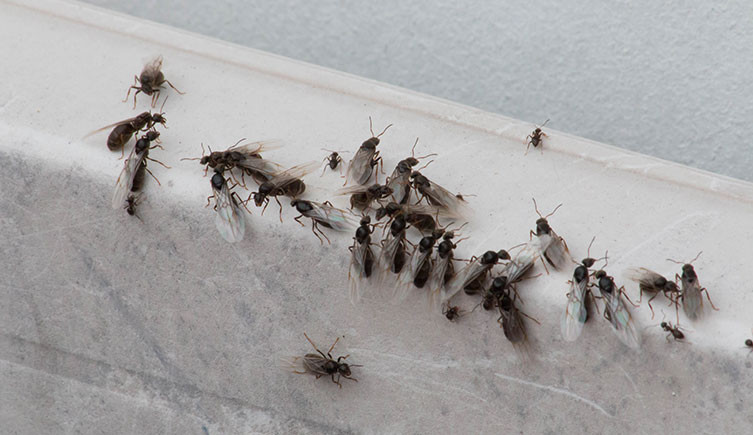 Winged ants on a building
Winged ants on a building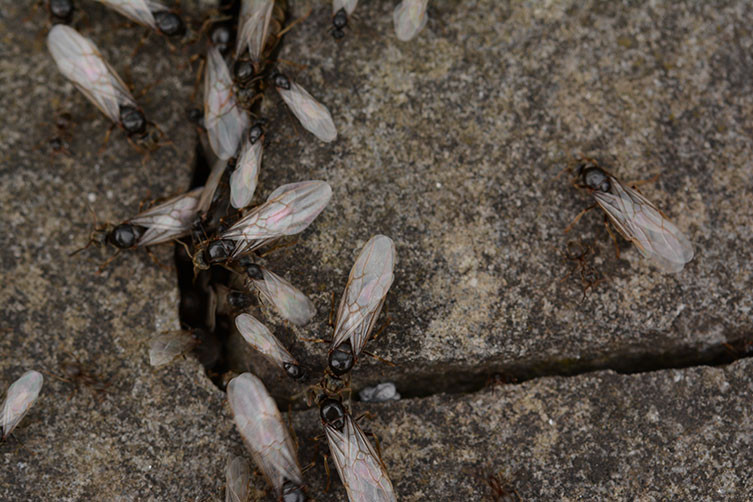 Winged ants about to fly
Winged ants about to fly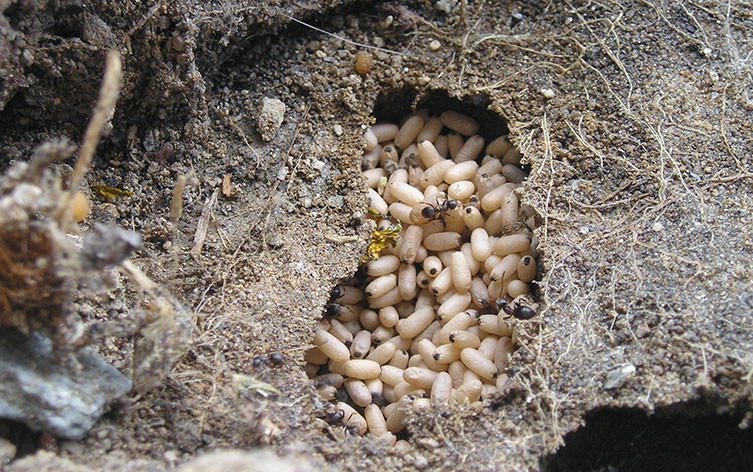 Exposed ant nest
Exposed ant nest Lots of winged ants in a corner between bricks
Lots of winged ants in a corner between bricks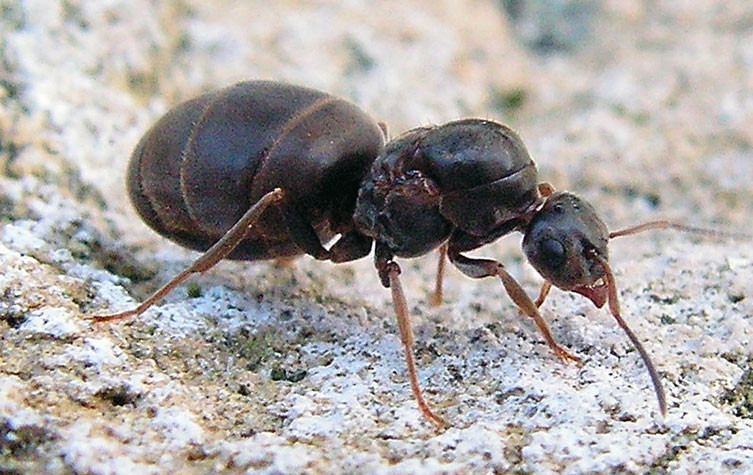 A queen ant that no longer has wings
A queen ant that no longer has wings Three flying seagulls
Three flying seagulls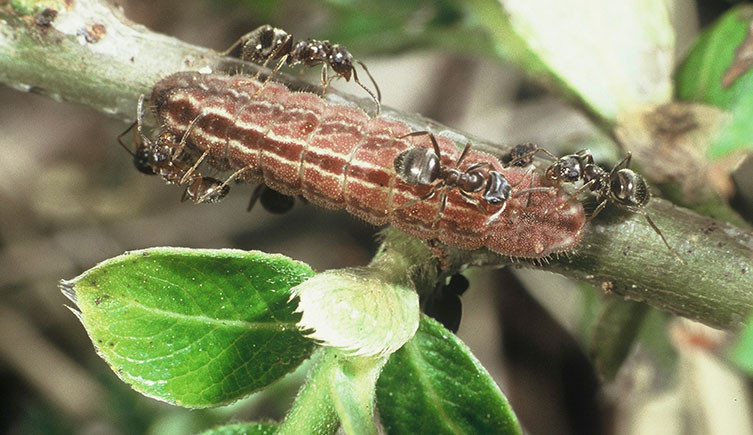 A few ants on a Plebejus argus caterpillar
A few ants on a Plebejus argus caterpillar